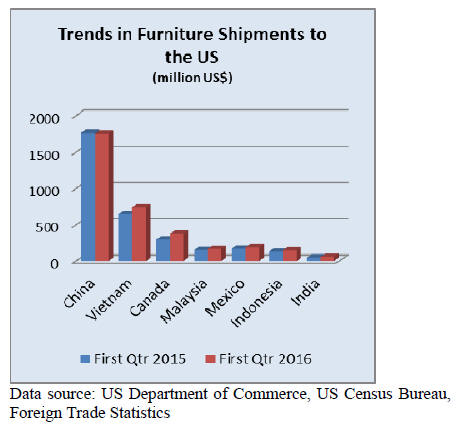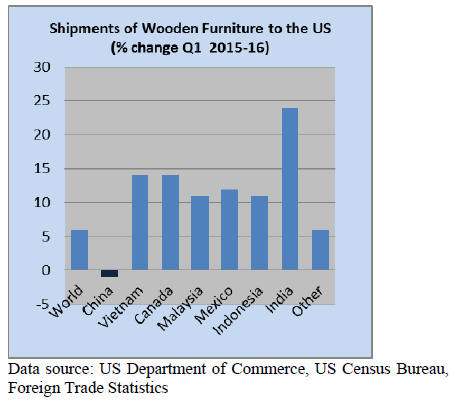|
Report from
North America
Consumer confidence rebounds
Consumer confidence rebounded in early May, according
to the University of Michigan Index of Consumer
Sentiment. Consumers reported income gains, an
improved job outlook, and they expect of lower inflation
and interest rates.
The largest improvement in confidence was amongst
lower income and younger households. Consumer
confidence rose in all regions of the country.
Builder confidence unchanged
Builder confidence in the market for new single-family
homes was unchanged in May, according to the National
Association of Home Builders/Wells Fargo Housing
Market Index. Builders expect more house sales in the
coming six months, but building lot shortages affect many
regions of the country, especially in the West.
Sixty-four percent of builders said the supply of lots was
¡°low¡± or ¡°very low¡± according to the May survey by the
National Association of Home Builders.
Housing starts expected to grow throughout 2016
Housing starts in April were at a seasonally adjusted
annual rate of 1,172,000, according to US Census Bureau
data. This is 7% up from March, but slightly below the
April 2015 rate.
Both single and multi-family home construction recovered
in April, with stronger growth in the multi-family sector.
Single-family homes were started at a rate of 778,000 in
April.
Developers of multi-family housing remain cautiously
optimistic about the market, according to the National
Association of Home Builders. Overall housing starts will
likely grow in the summer and fall of 2016 with steady
economic growth and an improving job market.
The number of building permits issued in April was at a
seasonally adjusted rate of 1,116,000, up 4% from March.
In Canada, housing starts declined 5% in April at a
seasonally adjusted annual rate because of lower multifamily
starts. A moderation in housing starts is expected
for 2016, especially in the oil producing regions of the
country. Moreover large forest fires shut down oil
production facilities northern Alberta and partially
destroyed the nearby city of Fort McMurray.
Low mortgage rates support home sales
Sales of existing homes increased for the second
consecutive month, according to the National Association
of Realtors. Home sales were up 6% from April 2015, and
the median home price was also up 6% from last year.
Sales rose in the Midwest and Northeast, but declined
slightly in the South and West. In the West housing
shortages and high prices slowed down sales.
Mortgage rates remain low. According to Freddie Mac, the
average commitment rate for a 30-year, conventional,
fixed-rate mortgage was 3.61% in April, which is the
lowest since May 2013 (3.54 percent).
Tropical sawnwood imports up in March except sapelli
The US imported 80,626 cu.m. of sawn hardwood in
March, down 16% from the previous month. However, the
value of imports grew 4% largely due to higher tropical
imports.
Overall sawn hardwood imports were worth US$41.1
million in March. Tropical sawnwood accounted for half
of the import value at US$20.4 million.
Tropical sawnwood imports increased 21% in March to
19,828 cu.m. Year-to-date imports remained lower than in
March 2015 (-24%). Imports of all major species grew in
March, with the exception of sapelli which remained
unchanged from the previous month at 2,003 cu.m. Yearto-
date sapelli imports were only half the volume at the
same time last year.
Ipe sawnwood imports increased 53% month-over-month
to 3,001 cu.m. in March. Year-to-date imports were still
25% lower than in March 2015.
While most species had lower year-to-date imports than in
2015, balsa and mahogany imports grew in 2016 up to
March. March imports of balsa sawnwood were 4,562
cu.m., up 2% year-to-date. Imports of mahogany
increased 31% year-to-date to 1,644 cu.m. in March.
After declining in February keruing sawnwood imports
almost doubled from the previous month to 1,881 cu.m. in
March.
Ecuador was the largest source of tropical sawnwood
imports in March, followed by Brazil, Malaysia and
Cameroon.
Of the smaller sawnwood suppliers, Guatemala increased
shipments to the US to 987 cu.m. in March. Imports from
India on the other hand, declined from over 1,218 cu.m. in
February to almost zero in March.
Canada imported more balsa in March
In March the value of Canadian imports of tropical
sawnwood was down 4% from the previous month due to
lower imports of sapelli. Imports were worth USUS$1.67
million. Year-to-date imports were still higher than in
March 2015.
Sapelli sawnwood imports declined 10% month-overmonth
to USUS$504,207, but sapelli remains the main
tropical species imported into Canada.
At USUS$30,767 March imports of mahogany were up
from February. Imports of virola, imbuia and balsa
(combined) grew by one third to USUS$451,344 in
March. Much of the growth was in balsa imports from
Ecuador.
Sawnwood imports from Cameroon fell to USUS$357,498
in March, while imports from Congo (formerly
Brazzaville) increased to USUS$306,074. Brazil¡¯s
shipments to Canada declined in March, but the year-todate
value is 43% higher than at the same time last year.
Hardwood plywood
US imports of hardwood plywood, moulding and wooden
furniture declined in March from the previous month.
Only wood flooring imports grew, but they remain lower
than at the same time in 2015. Much of the decline was in
imports from China, while most other countries were able
to expand their share in US imports in March.
Drop in plywood imports from China
Hardwood plywood imports declined again month-overmonth
in March (-9%). A total of 234,473 cu.m. were
imported in March, worth US$133.2 million. Year-to-date
import volumes were 2% higher than in March 2015, but
the value in current US dollars was down 5%.
The drop in imports was almost entirely in shipments from
China, which fell by 29% to 112,275 cu.m. in March.
Imports from Indonesia, Malaysia and Russia increased
from February.
Plywood imports from Indonesia grew 22% from the
previous month to 37,325 cu.m. Year-to-date import
volumes from Indonesia were down 5% from March last
year, but the value of imports grew 7% year-to-date.
Imports from smaller plywood suppliers to the US market
expanded significantly in March, most notably from Spain
(4,056 cu.m.), Uruguay (3,885 cu.m.) and Brazil (2,948
cu.m.).
Moulding imports from China down, Brazil up
Hardwood moulding imports were worth US$13.8 million
in March, down 12% from the previous month. Year-todate
imports were unchanged from March 2015.
Moulding imports from China and Malaysia fell in March,
while Brazil and Canada increased shipments to the US
market. Imports from Brazil recovered from February and
were worth US$3.6 million. China¡¯s moulding shipments
dropped to US$3.3 million in March.
Hardwood moulding imports from Italy were
exceptionally high in March at US$1.2 million.
Growth in assembled flooring panels from Thailand
Wood flooring imports grew month-over-month in March,
but year-to-date imports remained below March 2015
levels for both hardwood and panel flooring. Hardwood
flooring imports were up 10% (US$2.6 million), while
imports of assembled flooring panels increased 11% to
US$10.5 million.
Hardwood flooring imports from Malaysia were
US$667,504 in March, up 70% from February. Indonesian
shipments more than tripled in March from the previous
month to US$612,429.
Hardwood flooring imports from China decreased from
the previous month to US$347,254, but remain higher
year-to-date than in March 2015.
China¡¯s shipments of assembled wood flooring panels
grew 3% month-over-month in March to US$4.1 million.
Imports from most other suppliers increased as well in
March. Thailand has recently become a significant
supplier to the US market, exceeding imports from
Indonesia year-to-date 2016. March imports from Thailand
were worth US$767,521.
Assembled flooring panel imports from Europe also
increased in March, especially imports from Poland.
Wooden furniture imports down 22%
Wooden furniture imports fell 22% in March to US$1.08
billion, but imports from most countries grew. The largest
decrease was in imports from China (US$397.2 million, -
41%) and Vietnam (US$180.7 million, -36%).

Year-to-date imports were still 6% higher than in March
2015.
Furniture imports from Malaysia declined to US$51.6
million in March, while imports from Indonesia grew 17%
to US$53.1 million.

Canada¡¯s furniture exports to the US increased in March
and its share in total imports was over 11%, up from under
8% in previous months. China¡¯s import share was only
37% in March, down from almost 50%.
Furniture imports from India increased to US$23.9 million
in March. Europe also grew its market share in the US
helped by a favourable exchange rate. Italy was the largest
supplier at US$50.1 million in March, followed by Poland
and Germany.
Imports of all types of wooden furniture declined in
March, but the drop was greatest in upholstered furniture.
Office furniture imports decreased the least.
Office furniture demand expected to grow 7.4% in 2016
US demand for office furniture appears to be growing
more strongly than household furniture consumption,
based on international trade data and forecasts by IHS
Global Insight and the Business + Institutional Furniture
Manufacturers Association (BIFMA).
In 2015 US office furniture imports were higher than in
2008 before the recession hit the country. 2015 imports
were worth US$1.4 billion. Wooden furniture accounted
for 65% of total office furniture imports.
US production of office furniture is expected to reach
US$10.4 billion in 2016, according to predictions by
BIFMA and IHS Global Insight. This would be a slight
increase from 2015, while consumption is forecast to grow
7.4% to US$14.0 billion.
A major area of work for BIFMA has been the
sustainability of office furniture.
The association is currently working on revising the
ANSI/BIFMA e3 Furniture Sustainability Standard. More
than 60 manufacturers certify over 7,000 product lines
through the third-party certification program for the
sustainability standard. The revision of the standard will
clarify support for green building rating systems, update
the chemistry assessment and include for life cycle based
assessments.
Wood product industry leads growth in manufacturing
Economic activity in the manufacturing sector expanded in
April for the second consecutive month, according to the
Institute for Supply Management. The overall economy
also grew in April.
Wood product manufacturers reported the strongest
growth of all manufacturing industries, while the furniture
industry contracted in April, according to the institute¡¯s
survey. Furniture manufacturers reported higher new
orders and production, but regarded their customers¡¯
inventories too high in April. New orders for export drove
growth in the wood products industry.
Development of architectural woodwork standard
diverges
The Architectural Woodwork Manufacturers Association
of Canada and the Woodwork Institute based in California
plan to develop a new architectural woodwork standard for
North America.
The announcement in March follows a dispute with a third
industry body, the Architectural Woodwork Institute based
in Virginia. The latter received official approval as an
American National Standards Institute (ANSI) Accredited
Standards Developer of architectural woodwork standards.
All three organizations collaborated on the existing
Architectural Woodwork Standards publication, which
serves as a reference manual for design professionals to
clarify guidelines, information and principles required for
fabrication, and finishing and installation of architectural
woodwork.
Previously the goal of all three associations was to provide
a single architectural woodwork standard for Canada and
the US. Now the Architectural Woodwork Institute will
develop an ANSI Standard, while the other two
organizations will update the Architectural Woodwork
Standards, currently in its second edition.
Higher interest rates likely this summer
GDP increased at an annual rate of 0.8% in the first
quarter of 2016, according to the second estimate released
by the US Department of Commerce. The unemployment
rate was unchanged in April at 5.0%. Both the
unemployment rate and the number of unemployed
persons have changed little since August 2015.
The US Federal Reserve may raise interest rates again in
either June or July, despite slow economic growth in the
US, economic troubles in Brazil and China, and the UK¡¯s
vote in late June on whether to leave the EU. Federal
Reserve Chair Janet Yellen announced on May 27 that
higher rates may be set in the coming months.
|